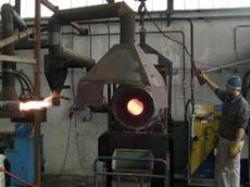Aug 16 2013
Researchers from the Plant Nutrition Group at ETH Zurich have been evaluating methods to develop an efficient and environmental friendly phosphate fertilizer from sewage sludge ashes. A new thermo-chemical process that extracts heavy metals could be the answer.
 Rotary kiln: used in the thermal-chemical process to remove heavy metals and recover phosphorus from sewage sludge ash. (Photo: ETH Zurich)
Rotary kiln: used in the thermal-chemical process to remove heavy metals and recover phosphorus from sewage sludge ash. (Photo: ETH Zurich)
One of the main benefits of using sewage sludge as a fertilizer is that valuable plant nutrients are recycled from society back into the agricultural system – in this respect, completely sustainable. The downside, however, is that there is also a risk of introducing potentially harmful chemicals into the soil, posing a risk to both the environment and human health. In fact, using pure sewage sludge to fertilize an agricultural field was forbidden in 2008 in Switzerland for this very reason.
As an alternative, it is incinerated and the ashes are used to produce a fertilizer. While this process eliminates harmful organic chemicals, continual fertilization with the ashes causes heavy metals to accumulate in the soil, which may result in lower crop yields, reduced biological activity in the soil and increased concentrations of heavy metals in crops.
Prosperous phosphorus
Despite the offsets, sewage sludge remains a topic of debate. Rejecting it all together would mean discarding fair amounts of phosphorus and other valuable plant nutrients it contains. Essentially, there is added value in improving methods just to recover phosphorus alone; while global phosphate reserves are in decline, phosphorus in human waste streams is accumulating. Hence, the increasing interest in preservation or recovery technologies.
In Switzerland, it has become clear that a more sustainable and economical system needs to be implemented. The canton of Zurich is already making plans to implement a phosphorus recycling technology by 2015 and is working with the Plant Nutrition Group at ETH Zurich to evaluate various methods.
Breaking ground
Within the scope of the Phoskraft, researchers from the Plant Nutrition Group at ETH have been investigating phosphate fertilizer efficiency, heavy-metal removal and bioavailability and the economy of a sewage sludge ash based fertilizer, understanding the importance of developing better systems and techniques that satisfy the criteria for both nutrient recycling and environmental protection. “Phosphorous is a key nutrient in human, animal and plant life. This finite resource must be cycled more efficiently,“ asserts Simone Nanzer, a lead researcher in the project who specialises in evaluating phosphate fertilizer from sewage sludge ashes.
One ground-breaking project involves an Austrian company that developed a new thermal-chemical process to decontaminate and extract heavy metals from the ashes of sewage sludge. Because the method was new, little was known about the phosphorus availability to plants. The Plant Nutrition Group at ETH was then contacted and asked to evaluate the company’s new patented methodology. “Before commercialization can begin, phosphorus availability to crops must be assessed as well as the environmental risks,” explains Nanzer. “According to our findings the method remarkably reduces the risk of heavy metal soil contamination in comparison to sewage sludge or untreated sewage sludge ash. Moreover, it is unique in that it produces a residue with a high phosphorus content, which can potentially become a marketable phosphate fertilizer.”
The way forward
Nanzer’s findings also revealed that there is room for improvement. Although the residue created by the thermo-chemical process could be sustainably and economically cycled back into agriculture and turned into a valuable fertilizer, phosphorus availability to plants would only be good in acidic and neutral soil conditions. “In alkaline soil conditions, the chemical reaction of the material is not high enough to make phosphorus available to plants,” Nanzer clarifies. “Modifications to the process need to be made and tested in future research.”
While, the thermal-chemical process is one of the most advanced methods in terms of decontamination, the ETH Plant Nutrition Group continues to evaluated other methods that may prove to be more economical.